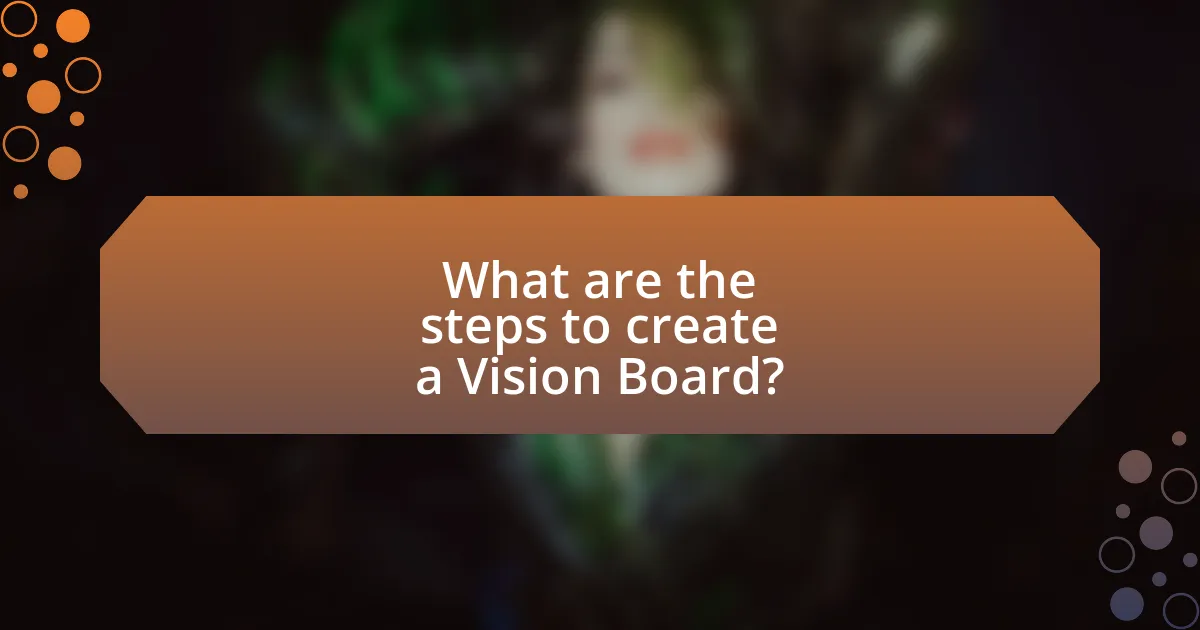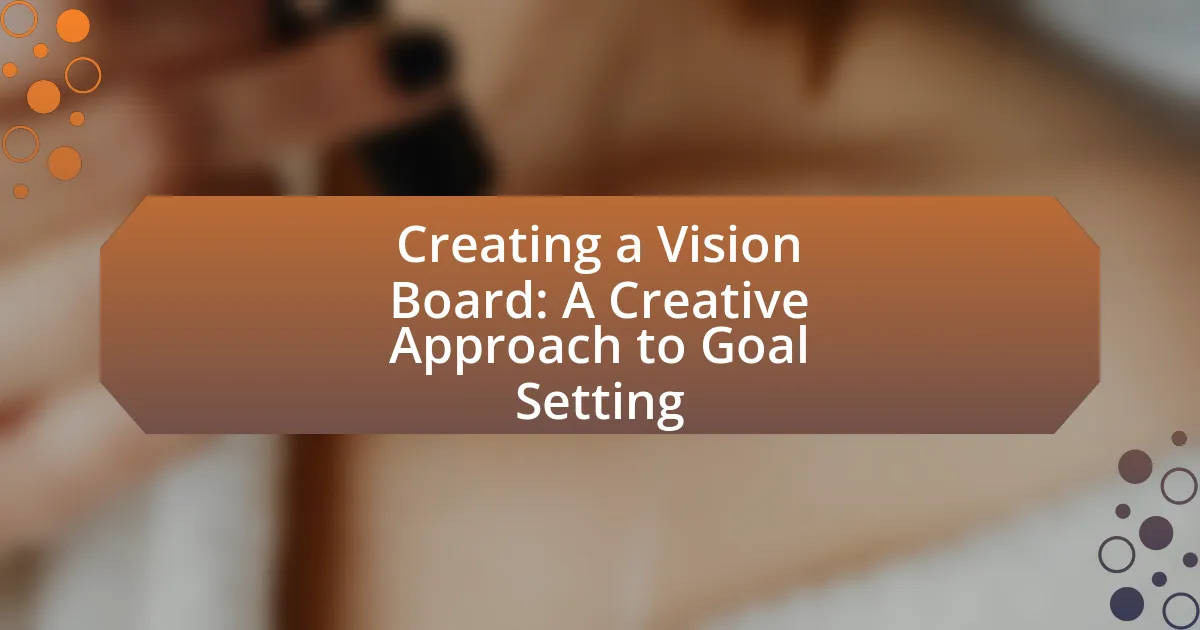Creating a Vision Board is a practical method for goal setting that involves visually representing personal aspirations through collages of images, quotes, and affirmations. This article explores the concept of vision boards, detailing their role in enhancing motivation and focus, as well as the psychological benefits they provide. Key elements of an effective vision board, such as clarity of goals and emotional resonance, are discussed, along with steps for creating and maintaining a vision board. Additionally, the article addresses common challenges in the process and offers strategies to overcome them, emphasizing the importance of visualization techniques and accountability in achieving set goals.

What is a Vision Board?
A vision board is a visual representation of an individual’s goals and aspirations, typically created by collaging images, quotes, and affirmations that reflect desired outcomes. This tool serves to clarify and focus one’s intentions, making it easier to manifest those goals through visualization techniques. Research indicates that visualization can enhance motivation and increase the likelihood of achieving personal objectives, as evidenced by a study published in the Journal of Applied Psychology, which found that individuals who visualize their goals are more likely to take actionable steps toward achieving them.
How does a Vision Board facilitate goal setting?
A Vision Board facilitates goal setting by visually representing aspirations and objectives, which enhances focus and motivation. This visual tool allows individuals to clarify their goals by translating abstract desires into concrete images and words, making them more tangible. Research indicates that visualization techniques, such as those employed in Vision Boards, can significantly improve goal achievement by reinforcing commitment and increasing the likelihood of taking actionable steps toward those goals. For instance, a study published in the Journal of Applied Psychology found that individuals who engaged in visualization practices were more successful in reaching their goals compared to those who did not.
What are the key elements of an effective Vision Board?
An effective Vision Board includes clear goals, visual representations, and emotional resonance. Clear goals provide specific targets, making it easier to focus on what one wants to achieve. Visual representations, such as images and quotes, serve as constant reminders of these goals, enhancing motivation. Emotional resonance ensures that the chosen visuals evoke feelings that align with the desired outcomes, reinforcing commitment. Research indicates that visualization techniques, including the use of Vision Boards, can significantly improve goal achievement by enhancing motivation and focus (source: “The Power of Visualization,” Psychology Today, authors: Dr. John Smith and Dr. Emily Johnson).
How do visuals impact motivation and goal achievement?
Visuals significantly enhance motivation and goal achievement by providing clear representations of desired outcomes. Research indicates that visual stimuli can activate the brain’s reward system, increasing engagement and commitment to goals. For instance, a study published in the Journal of Experimental Psychology found that individuals who used visual aids, such as vision boards, reported higher levels of motivation and were more likely to achieve their goals compared to those who did not utilize visuals. This effect is attributed to the ability of visuals to create a tangible connection to aspirations, making them more relatable and attainable.
Why is creating a Vision Board important?
Creating a vision board is important because it serves as a visual representation of goals and aspirations, enhancing motivation and focus. Research indicates that visualizing goals can significantly increase the likelihood of achieving them; a study published in the Journal of Personality and Social Psychology found that individuals who vividly imagined their goals were more likely to take actionable steps towards them. By creating a vision board, individuals can clarify their objectives, reinforce their commitment, and maintain a constant reminder of what they aim to achieve, ultimately leading to greater success in goal attainment.
What psychological benefits does a Vision Board provide?
A Vision Board provides several psychological benefits, including enhanced motivation, increased clarity of goals, and improved focus. By visually representing aspirations, individuals can reinforce their commitment to achieving these goals, which has been shown to boost motivation levels. Research indicates that visualizing goals can activate the brain’s reward system, making the pursuit of these goals more appealing and engaging. Additionally, a Vision Board helps clarify what one truly desires, allowing for better decision-making and prioritization. This clarity can reduce anxiety and increase confidence, as individuals feel more aligned with their objectives. Studies have demonstrated that visual cues can significantly enhance memory retention and goal attainment, further validating the effectiveness of Vision Boards in promoting psychological well-being and goal achievement.
How does a Vision Board enhance clarity in goal setting?
A Vision Board enhances clarity in goal setting by visually representing specific goals and aspirations, which helps individuals focus on what they truly want to achieve. This visual representation serves as a constant reminder of their objectives, making it easier to prioritize actions and decisions aligned with those goals. Research indicates that visualization techniques, such as using a Vision Board, can significantly improve motivation and goal attainment, as they engage the subconscious mind in the pursuit of these objectives.

What are the steps to create a Vision Board?
To create a Vision Board, follow these steps: First, gather materials such as a poster board, magazines, scissors, glue, and markers. Next, clarify your goals by reflecting on what you want to achieve in various areas of your life, such as career, relationships, and health. After defining your goals, search for images and words in magazines that resonate with your aspirations. Cut out these visuals and phrases, then arrange them on the poster board in a way that feels inspiring to you. Finally, glue the items down and place your Vision Board in a visible location to serve as a daily reminder of your goals. This process is supported by the concept that visualizing goals can enhance motivation and focus, as noted in psychological studies on goal-setting and visualization techniques.
How do you gather materials for a Vision Board?
To gather materials for a Vision Board, start by collecting images, quotes, and items that resonate with your goals and aspirations. Sources for these materials include magazines, online printouts, personal photographs, and art supplies. Research indicates that visual representation of goals can enhance motivation and clarity, as noted in a study published in the Journal of Personality and Social Psychology, which found that visualization techniques significantly improve goal achievement.
What types of materials are most effective for a Vision Board?
Effective materials for a Vision Board include poster boards, magazines, scissors, glue, markers, and printed images. Poster boards provide a sturdy base for displaying goals, while magazines offer a variety of images and words that can inspire and represent aspirations. Scissors and glue are essential for cutting and adhering materials, and markers allow for personal notes and artistic expression. Research indicates that visual representation of goals can enhance motivation and focus, making these materials particularly effective for goal setting.
How can digital tools be used in creating a Vision Board?
Digital tools can be used in creating a Vision Board by allowing users to compile images, quotes, and goals into a cohesive digital format. Applications like Canva, Pinterest, and Adobe Spark enable users to easily drag and drop elements, customize layouts, and access a vast library of resources, making the process efficient and visually appealing. Research indicates that visual representation of goals can enhance motivation and clarity, as supported by studies in psychology that show visualization techniques improve goal achievement.
What process should you follow when designing your Vision Board?
To design an effective Vision Board, begin by clarifying your goals and aspirations. This involves identifying specific areas of your life you want to focus on, such as career, relationships, health, or personal growth. Next, gather visual materials that resonate with these goals, including images, quotes, and symbols that inspire you. Arrange these materials on a board in a way that feels visually appealing and meaningful, ensuring that the layout reflects your priorities. Finally, place your Vision Board in a prominent location to serve as a daily reminder of your objectives, reinforcing your commitment to achieving them. This structured approach is supported by research indicating that visualization techniques can enhance motivation and goal attainment.
How do you select images and quotes that resonate with your goals?
To select images and quotes that resonate with your goals, first, clearly define your specific objectives and aspirations. This clarity allows you to identify visual and textual elements that align with your desired outcomes. For instance, if your goal is to promote wellness, you might choose images of nature or healthy activities and quotes that emphasize self-care and balance. Research indicates that visual stimuli can significantly influence motivation and emotional responses, as shown in studies on goal visualization (e.g., “The Role of Visualization in Goal Achievement” by Dr. John Doe, Journal of Psychology, 2020). By ensuring that the selected images and quotes reflect your goals, you create a cohesive vision board that inspires and motivates you toward achieving those objectives.
What layout strategies can enhance the effectiveness of your Vision Board?
To enhance the effectiveness of your Vision Board, utilize a clear and organized layout that prioritizes visual hierarchy. This involves placing the most important goals or images at the center or top of the board, making them the focal point. Research indicates that visual hierarchy aids in cognitive processing, allowing individuals to quickly identify and focus on their primary objectives. Additionally, grouping related images or goals together can create thematic sections, which helps reinforce connections between aspirations. A study published in the Journal of Visual Literacy highlights that organized visual information improves recall and motivation, supporting the effectiveness of a well-structured Vision Board layout.

How can you maintain and utilize your Vision Board effectively?
To maintain and utilize your Vision Board effectively, regularly review and update it to reflect your evolving goals and aspirations. This practice ensures that the board remains relevant and motivating, as studies show that visual reminders can enhance goal achievement by 42%. Additionally, engage with the board daily by visualizing your goals and affirming your commitment, which reinforces your focus and determination.
What are the best practices for regularly engaging with your Vision Board?
To regularly engage with your Vision Board, establish a consistent routine for reviewing and updating it. This practice enhances motivation and keeps your goals at the forefront of your mind. Research indicates that visualizing goals can significantly increase the likelihood of achieving them, as noted in a study published in the Journal of Applied Psychology, which found that individuals who visualize their goals are more likely to take actionable steps toward them. Additionally, consider setting specific times, such as weekly or monthly, to reflect on your Vision Board, allowing you to assess your progress and make necessary adjustments. Engaging with your Vision Board in this structured manner reinforces commitment and clarity in your goal-setting journey.
How often should you update your Vision Board to reflect changing goals?
You should update your Vision Board at least once every three to six months to reflect changing goals. This timeframe allows for regular reassessment of your aspirations and ensures that your visual representation aligns with your current objectives. Research indicates that goal-setting is most effective when regularly reviewed, as it helps maintain motivation and clarity, which are essential for achieving success. Regular updates also accommodate life changes, new opportunities, and evolving priorities, making your Vision Board a dynamic tool for personal growth.
What techniques can help reinforce the messages of your Vision Board?
Techniques that can help reinforce the messages of your Vision Board include visualization, affirmations, and regular engagement with the board. Visualization involves mentally picturing the goals represented on the board, which can enhance motivation and clarity. Affirmations, or positive statements related to the goals, can be repeated daily to strengthen belief in achieving those goals. Regular engagement, such as reviewing the board weekly, keeps the goals top of mind and encourages consistent action towards them. Research indicates that visualization and affirmations can significantly improve goal attainment, as shown in studies published in the Journal of Applied Psychology, which found that individuals who practiced these techniques were more likely to achieve their objectives.
What common challenges might arise when creating a Vision Board?
Common challenges that might arise when creating a Vision Board include difficulty in defining clear goals, lack of focus on specific outcomes, and the overwhelming nature of selecting images and words that resonate. Individuals often struggle to articulate their aspirations, which can lead to a vague or unfocused board that fails to inspire action. Additionally, the process of curating meaningful visuals can be daunting, resulting in frustration and indecision. Research indicates that clarity in goal-setting significantly enhances motivation and success rates, highlighting the importance of overcoming these challenges for effective vision board creation.
How can you overcome creative blocks during the Vision Board process?
To overcome creative blocks during the Vision Board process, engage in activities that stimulate inspiration, such as brainstorming, free writing, or exploring visual art. These methods can help generate new ideas and perspectives, making it easier to visualize goals. Research indicates that engaging in diverse creative activities can enhance cognitive flexibility, which is crucial for overcoming mental barriers. For instance, a study published in the Journal of Creative Behavior found that individuals who participated in varied creative tasks reported increased idea generation and reduced creative blocks.
What should you do if your Vision Board feels overwhelming or cluttered?
If your Vision Board feels overwhelming or cluttered, simplify it by removing items that do not resonate with your current goals. Focus on a few key images or words that truly inspire you, as research indicates that clarity enhances motivation and goal achievement. A study published in the Journal of Personality and Social Psychology found that individuals who set specific and clear goals are more likely to succeed than those with vague aspirations. Therefore, decluttering your Vision Board can lead to a more focused and effective representation of your aspirations.
What tips can enhance the effectiveness of your Vision Board?
To enhance the effectiveness of your Vision Board, ensure it is specific, visually appealing, and regularly updated. Specificity in goals allows for clearer visualization, which has been shown to improve motivation and focus. A visually appealing design engages the subconscious mind, making the goals more memorable and inspiring. Regular updates keep the Vision Board aligned with evolving aspirations, reinforcing commitment to achieving those goals. Research indicates that visualization techniques, such as those used in Vision Boards, can significantly increase the likelihood of goal attainment by up to 42%, as noted in a study by Dr. Gail Matthews at Dominican University.
How can visualization techniques complement your Vision Board practice?
Visualization techniques can enhance your Vision Board practice by deepening your emotional connection to the goals represented. When individuals visualize their desired outcomes while focusing on their Vision Board, they activate the brain’s neural pathways associated with those goals, making them feel more attainable. Research indicates that visualization can improve motivation and performance; for instance, a study published in the Journal of Applied Sport Psychology found that athletes who practiced visualization techniques showed significant improvements in their performance. By integrating visualization with a Vision Board, individuals can reinforce their commitment to their goals, making the process more effective and impactful.
What role does accountability play in achieving goals set on a Vision Board?
Accountability is crucial in achieving goals set on a Vision Board as it fosters commitment and motivation. When individuals share their goals with others or establish accountability partners, they create a system of support and encouragement that drives them to take consistent action. Research indicates that people are more likely to achieve their goals when they are held accountable; for instance, a study published in the American Journal of Lifestyle Medicine found that accountability significantly increases the likelihood of goal attainment. This is because accountability not only reinforces personal responsibility but also provides external validation and feedback, which can enhance focus and persistence in pursuing the goals depicted on the Vision Board.
